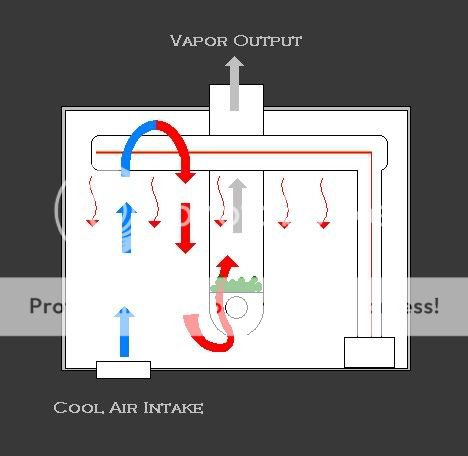Thank you for the input everyone!
It might be a while until i can illustrate this graphically, please pardon me for re-using the images i've posted previously. Only a slight substitution is involved anyway, imagine that the thin helical fin has been replaced by a coiled quartz glass tube filled with small ferro-magnetic beads and there you go:
Actually, i have a few more changes in mind for the SHOT GUN VAPORIZER v4.0 but lets focus on heating at the moment. For the time being it's still based on a modified VapBong-like amovible core, nonetheless (i love this type of versatility).

Even though direct wiring is gone and i'm done with oven-style heat insulation, some restrictions remain; such as the three chambers configuration for example. In this setup the heating elements (red vertical bars) of my upper-left heating cavity are replaced by an induction coil. The right-most servo-control compartment and the lower-left detection chamber continue to be represented the way they are for all practical purposes.
The difference lies mainly in my 3 operation modes. Essentially, "Portable" mode is unchanged and simply depends only on tighter dimensions handling to be compatible. As for "Direct Use" and "Automatic" modes, that's where the benefits of induction heating really show up.
I'm not sure yet how the lower-left detection chamber would work exactly but we're all aware of the existance of materials with temperature-sensitive properties (see previous explanations). I favour non-contact optical detection because one fine option i wish to survive in v4.0 is the "Shaker" feature: my central core (the vial) is submitted to vibrations in order to favour deeper vaporization. When combined with energy monitoring the temperature records should make it possible to determine when there's vapor ready (e.g. that's when it's time to "inhale" by creating enough vacuum in the soft-drink bottle where a vapor bag resides to collect the vapor).
In fact, energy monitoring might also serve as a safeguard because it should be possible to make rough approximations of the energy required to reach a given temperature versus the ferro-magnetic mass contained in the beads. In case of doubt, an "hesitation" control loop would include sufficient delay in "Automatic" mode to allow my Glass-Rod Induction Heater Element to cool down (reset) a bit so that the software can regain control again (i mean when/if necessary at all). A second detection chamber added on top of the middle induction (heating) cavity could
eventually make both the "Direct Use" and "Automatic" modes even more accurate by monitoring
airflow as well (two sensors working together can do this).

It's true that materials like glass and ceramic are totally transparent in inductive heating applications. I may be mistaking but i believe brass too wouldn't get heated by a varying magnetic field
focussed on the middle section of my central core.
Consequently, this part of the VapBong-based design stays exactly the way it was, naturally translating into
convection heating as a result - a feature i'm not ready to sacrifice by the way! As a side-note i must point out that the detection chamber has a third function: to enhance seperation right before the vaporization bowl.
...
In short, heat would come from
inside the vial instead of outside, significantly reducing the needs for oven-style heat insulation. Additionally, that heat is going to stay
up within the vial since the later will be inserted vertically in the SHOT GUN VAPORIZER v4.0 appliance and hence the helical air path should help to keep it there until required - with the definite benefit that this would provide a reasonably massive reserve of hot air located not too far from the vaporization bowl but not so close we should become concerned by such proximity. Of course, things would probably differ on the long term though...

I know this may be difficult to visualize in absence of an adequate drawing but my Glass-Rod Induction Heater Element doesn't need to fit tightly where the helical fin was found before and that's some major bonus which comes with this radical design modification:
ease of manufacturing! After all, there are plenty of spiral shaped tubes around as we speak, how complex is it to fill one of them with ferrous beads really! The trade-off for a simpler mechanical structure is more demanding (clever) conception and we shouldn't expect anything less considering the price tag of comparable devices available today.





 unless you have really big pockets.
unless you have really big pockets.

























